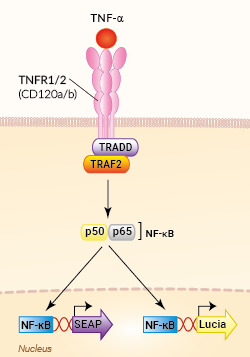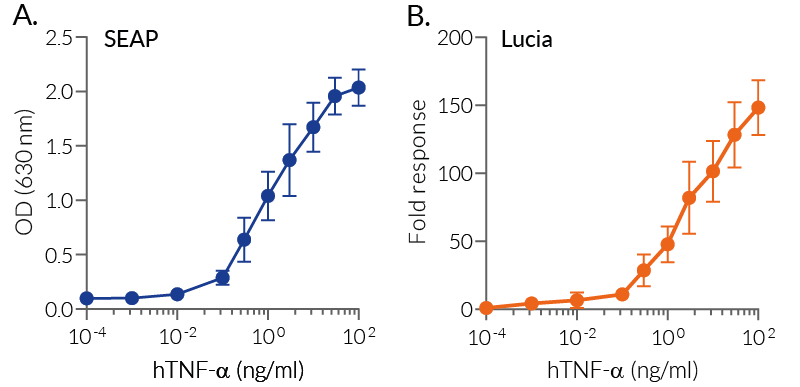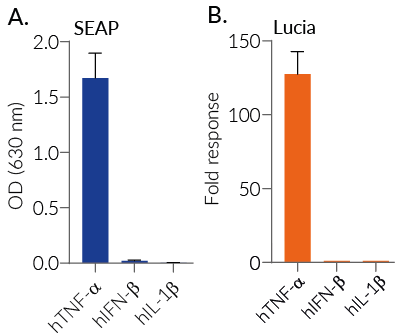HEK-Blue-Lucia™ TNF-α Cells
| Product | Unit size | Cat. code | Docs. | Qty. | Price | |
|---|---|---|---|---|---|---|
|
HEK-Blue-Lucia™ TNF-α Cells Human TNF-α double NF-κB–readout reporter cells |
Show product |
3-7 x 10e6 cells |
hkd-tnfa
|
|
||
|
HEK-Blue-Lucia™ TNF-α vial Additional cell vial |
Show product |
3-7 x 10e6 cells |
hkd-tnfa-av
|
Notification: Reference #hkd-tnfa-av can only be ordered together with reference #hkd-tnfa.
TNF-α reporter cells with SEAP and Lucia luciferase double read-out

Signaling pathways in HEK-Blue-Lucia™ TNF-α cells
HEK-Blue-Lucia™ TNF-α* cells were engineered from the human embryonic kidney HEK293 cell line to detect bioactive human tumor necrosis factor-alpha (TNF-α) by monitoring the activation of the NF-κB pathway. In addition, these cells can be used for screening antibodies or small molecule inhibitors targeting the TNF-α pathway.
TNF-α is a multi-functional pro-inflammatory cytokine involved in the regulation of a wide spectrum of biological processes, such as cell proliferation, differentiation, and apoptosis [1].
Cell line description
HEK-Blue-Lucia™ TNF-α cells were generated by stable transfection with the genes encoding for two NF-κB-inducible reporters: secreted embryonic alkaline phosphatase (SEAP) and Lucia luciferase. This feature allows the double readout of the NF-κB actiavtion upon the binding of TNF-α to its receptor, by monitoring the activity of SEAP and Lucia luciferase using QUANTI-Blue™ Solution and QUANTI-Luc™ 4 Lucia/Gaussia, respectively.
HEK-Blue™ TNF-α cells detect human (h) TNF-α. Of note, these cells are not responsive to hIL-1β, and hIFN-β (see figures).
Key features
- Fully functional TNF-α signaling pathway
- Readily assessable NF-κB-inducible SEAP and Lucia luciferase reporter activities
- Strong response to humanTNF-α
- No response to human IL-1β
Applications
- Detection and quantification of human TNF-α activity
- Screening of anti-TNF-α or anti-TNFR1/TNFR2 antibodies
- Screening of small molecule inhibitors of the TNF-α pathway
Note: This cell line has been renamed. It was formerly known as "HEK-Dual™ TNF-α". The cat. code (hkd-tnfa) remains unchanged.
Reference:
1.Steeland S, Libert C, Vandenbroucke RE. 2018. A New Venue of TNF Targeting. Int J Mol Sci.;19(5):1442.
Back to the topSpecifications
Antibiotic resistance: Zeocin®
Growth medium: DMEM, 4.5 g/l glucose, 2 mM L-glutamine, 10% (v/v) heat-inactivated fetal bovine serum, 100 U/ml penicillin, 100 μg/ml streptomycin, 100 μg/ml Normocin®
Specificity: Detects human TNF-α
Detection range:
- Using QUANTI-Blue™ Solution: 1 ng - 1 µg/ml
- Using QUANTI-Luc™ 4 Gaussia/Lucia®: 0.5 ng - 1 µg/ml
Quality Control:
- SEAP and Lucia® reporter activity in response to TNF-α is validated using functional assays.
- The stability for 20 passages following thawing is confirmed.
- These cells are tested for mycoplasma contamination.
Contents
- 1 vial containing 3-7 x 106 cells
- 1 ml of Zeocin® (100 mg/ml).
- 1 ml of Normocin® (50 mg/ml)
- 1 ml of QB reagent and 1 ml of QB buffer (sufficient to prepare 100 ml of QUANTI-Blue™ Solution, a SEAP detection reagent)
- 1 tube of QUANTI-Luc™ 4 Reagent, a Lucia luciferase detection reagent (sufficient to prepare 25 ml)
![]() Shipped on dry ice (Europe, USA, Canada, and some areas in Asia)
Shipped on dry ice (Europe, USA, Canada, and some areas in Asia)
Details
Tumor necrosis factor-alpha (TNF-α) is a pleiotropic inflammatory cytokine produced by several types of cells, predominantly activated macrophages [1.] TNF-α plays an important role in the immune response to microbial invasions and in the necrosis of specific tumors. Of note, as a potent mediator of inflammation, TNF-α has been implicated in the pathogenesis of several autoimmune and inflammatory diseases such as rheumatoid arthritis and inflammatory bowel disease [1,2].
TNF-α exists in two forms; a type II transmembrane protein and a mature soluble protein. The TNF-α transmembrane protein is proteolytically cleaved to yield a soluble protein [3], which subsequently forms a non-covalently linked homotrimer in solution. TNF-α binds two receptors TNFR1 and TNFR2 inducing signaling that involves TRADD, TRAF2, and RIP, and leads to the activation of the NF-κB and the MAPK pathways [4].
1. Sedger L. & McDermott M., 2014. TNF and TNF-receptors: From mediators of cell death and inflammation to therapeutic giants - past, present and future. Cytokine Growth Factor Rev. 25(4):453-72.
2. Li P. et al., 2017. Drugs for Autoimmune Inflammatory Diseases: From Small Molecule Compounds to Anti-TNF Biologics.Front Pharmacol .8:460.
3. Kriegler M. et al., 1988. A novel form of TNF/cachectin is a cell surface cytotoxic transmembrane protein: ramifications for the complex physiology of TNF. Cell. 53(1):45-53.
4. Wajant H. et al., 2003. Tumor necrosis factor signaling. Cell Death Differ. 2003 10(1):45-65.
Back to the top








